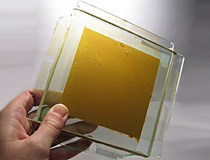| Plasma Display Panel Prototype | |
| Written by AnubisTTP on 2018-06-12 |
|
  |
It is often forgotten that a branch of the Nixie tube family tree terminates in a modern day consumer product; the flat panel plasma TV. The link between these two outwardly disparate devices is the cold cathode plasma display panel, or PDP. A plasma display panel is in effect, a flat 'Nixie' tube; crossed wire cathodes in a glass neon filled envelope result in a device that can display both text and graphics on a matrix of neon pixels. The first plasma display panel prototype was produced in 1966 by researchers at the University of Illinois, and as could be expected was a crude device by any standards. With a resolution of only 4x4 pixels and a package made from plate glass and vacuum epoxy, the University of Illinois prototype could only display a single character. It was not until 1971 that the first viable plasma bitmap product, a 512x512 panel produced for the PLATO computer system, entered the market.
The unidentified example shown here, made in 1972, is likely a prototype or short run product due to it's somewhat crude construction. Sadly this example has a broken nipple and no longer functions, though the soft-seal epoxy bonding the two glass plates together would have likely failed even if the tube was otherwise intact. We are unsure as to the manufacturer of this display, but suspect it was made by Fujitsu due to its construction style. Overall, this display is small, ugly, and low resolution, but in a world without liquid crystal panels, it was the only game in town.

Plasma display panel, unknown maker, dated 1972.

The PDP can display text or graphics using a matrix of crossed wires in a neon-filled envelope.

The first plasma display, produced by the University of Illinois in 1966, is shown above. This display contained a mix of neon and nitrogen, and only contained enough pixels to produce a single character.

This 'Plasma Scope' prototype digital storage oscilloscope, produced in 1972, used a Fujitsu neon plasma display panel very similar in construction to the unidentified panel shown above.
 Return to Nixie & Gas Discharge Displays
Return to Nixie & Gas Discharge Displays








 Return to Nixie & Gas Discharge Displays
Return to Nixie & Gas Discharge Displays